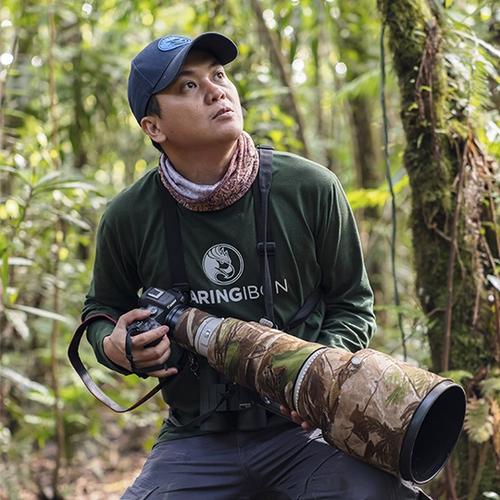Birding the Philippines Tour

We have added the Philippines as a new destination for our birding tours.
More information about the Philippines will be posted soon.
- Travel Dates: December 1 - 12, 2024
- Group Size: 6 travelers plus guides
- Trip Length: 12 days
- Rates: Rate per person = $4,750 ($1,080 extra charge for single occupancy)
- Rates include: Domestic transfers, lodging, breakfast, lunch, dinner, scheduled group tours, park entrance fees and basic travel insurance.
- Not included: International airfare, customs & immigration fees and visas, alcohol, trip cancellation insurance.
- Adventure level: Easy, please check the “Welcome” page for definition
Private Trips: We are increasingly taking people on private trips. If a group trip does not interest you, please contact us about a private tour and the dates you prefer.
Special offer: Included with your trip (one per room) is a copy of "Birds of the Greater Sundas, the Philippines, and Wallacea" (Princeton Illustrated Guide 2018), by Norman Arlott.
The Philippines: With 7,100 islands stretching from the Malayan-Indonesian complex in the south, close to Taiwan in the north, and sandwiched between the South China Sea and Pacific Ocean, the Philippines is both a rewarding place for birding. The processes of geography and evolution has left one of the highest degrees of endemism known in the world with 241 species of birds only found within the archipelago, while the list of non-endemics reaches around 468 species (WBCP Checklist of the Philippines 2020, as of 15 February 2020). These numbers have been increasing in recent years as more people are getting into birdwatching and more foreign tours visit the islands. Add to those species mainly found within islands and a huge potential for further splits, one can see the attraction for birding here.
There are three generally recognized geographical regions – Luzon, the Visayas and Mindanao, although for birdwatchers, the province of Palawan is an area that must be treated separately.
This birding tour will focus on locations within Luzon
The largest island with a limited number of associated islands off the north and east coasts, Luzon contain all the major habitats from mossy forest to marshlands. Due to logging, there is extremely limited lowland forest left but within most mountainous areas small remnants of forest can be found. The island is relatively easy and safe to move around and travel for birding. And there are some great birdwatching sites within or close to Metro Manila.
Basic Itinerary:
Day 1: Arrival in Manila
Flights are overnight (1-2 days) with arrival on day one. Flights arrive in Manila (MNL) at the Ninoy Aquino International Airport. You will be greeted at the airport and transported to the hotel. We will be staying at a hotel close to the airport for 2-nights.
Day 2: Las Piñas-Parañaque Wetland Park
The Las Piñas-Parañaque Wetland Park is composed of two interconnected islands with beach forest, mudflats and lagoons covering 175 hectares. Based on the bird sighting records of the WBCP, the wetland park was declared a critical habitat in 2007 and as a RAMSAR site in 2013. The park is the only site in Metro Manila that hosts the vulnerable Philippine Duck. There have also been sightings of the Chinese Egret. More than 80 species have been recorded such as the resident Rufous Night Heron, Black-crowned Night Heron, Barred Rail, Common Greenshank, Black-winged Stilt, Collared Kingfisher and more. Migration season brings in Kentish Plover, Common Redshank, Whiskered Tern among others.
Day 3: Manila - Los Baños, Laguna
One of the most popular places to go birdwatching in Metro Manila and probably where most local birders have had their first taste of birding is the University of the Philippines campus in Diliman, Quezon City. The main campus of the university sprawls over approximately 500 hectares of land and has a variety of habitats. A mix of endemics and resident species can be found in the main campus area – Striated Grassbird, Long-tailed Shrike, Philippine Magpie Robin, Philippine Pied Fantail, Philippine Hanging Parrot, Zebra Dove, Collared Kingfisher, Lowland White-eye, and Olive-backed Sunbird. On occasions, some urban rarities would show up like the Spotted Wood Kingfisher and Philippine Hawk Cuckoo. Notable migrant species that have been recorded here include Ferruginous Flycatcher, Narcissus Flycatcher and Chestnut-winged Cuckoo. Nocturnal birds include the Philippine Scops Owl and Philippine Nightjar. From Manila, it is a 1-hour drive to our next lodging location in Los Baños where we will spend 2-nights.
Day 4: Los Baños, Laguna
Mount Makiling Forest Reserve is a protected area known to contain a significant portion of the remaining highly diverse tropical rainforests in the country. Despite being located in a densely populated part of South Luzon, it is known to be home to rich assemblages of some of the country’s restricted-range bird species. An estimate of 120 bird species, with 59 endemics, have been recorded in the area. The long list includes the Luzon Bleeding-Heart, Philippine Trogon, Red-Crested Malkoha, Spotted Kingfisher, Luzon Hawk Owl, Philippine Nightjar, and a whole lot more. We will also have time to visit the Makiling Botanic Gardens.
Day 5: Infanta
From Los Baños, it a 2-hour drive our next birding location close to Infanta. This is a mountainous area; a very different habitat than the Los Baños area. Wil will spend 2-nights at this location. There will be a few birding spots on the drive there.
Day 6: Infanta
A full day birding the Infanta area where we will find endemic high altitude species such as fruit doves and the rufous hornbill. Most of the birding will be done from the roadside, but there are also a few trails to walk on.
Day 7: Infanta
Another full day of birding the Infanta area. A few of the birds on our list: Yellow-breasted Fruit Dove, Rufous-bellied Eagle, Brown-breasted Kingfisher, Philippine Pygmy Woodpecker, White-breasted Woodswallow, Blue-headed Fantail, Large-billed Crow, Citrine Canary-flycatcher, Elegant Tit, Grey-backed Tailorbird, Philippine Bulbul, Yellow-vented Bulbul, Lemon-throated Leaf Warbler, Yellowish White-eye, Blue-and-white Flycatcher, and Flaming Sunbird.
Day 8: Subic Bay
From our lodging near Infanta, it is 4-hour drive to Subic Bay, and of course there will be a few birding stops along the way.
Day 9: Subic Bay
The Subic Bay Metropolitan Area includes the biggest remaining patch of lowland tropical rainforest in Luzon facing the South China Sea. Owing to the protection the area received when it was still under the control of the U.S. Navy, large sections of original forest still remain. Nabasan Road is the last bastion of the endemic Green Racket-tail, the only place where Rufous Coucal is regularly seen, and the best place to find Luzon’s big woodpeckers: White-bellied Woodpecker, Luzon Flameback and Northern Sooty Woodpecker. It is also a good place to look for Philippine Hawk-eagle, Philippine Falconet, Whiskered Treeswift, Green Imperial Pigeon, Philippine Green Pigeon, Spotted Wood Kingfisher, Blackish Cuckooshrike, White-browed Shama, Chocolate Boobook, Luzon Hawk-Owl, Philippine Nightjar, Great-eared Nightjar, and Large-tailed Nightjar. It is also the destination for birders who aim to catch a glimpse of two of the country’s most elusive birds: White-lored Oriole and White-fronted Tit.
Day 10: Subic Bay
Another full day of biding the Subic Bay area.
Day 11: Manila
Today we will drive back to Manila, (2.5 hours), with one important stop along the way. La Mesa Eco Park is a 33-hectare public park adjacent to the La Mesa Watershed in North Fairview, Quezon City. As you enter the park, you’ll already be greeted by the sounds of Black-naped Orioles, Golden-bellied Gerygones, Philippine Pygmy Woodpeckers and Lowland White-eyes. A short walk will bring us to a small lagoon and terraces where the Barred Rail, White-breasted Waterhen, Collared Kingfisher, Common Kingfisher, and Philippine Coucal have been spotted. The main area for birding, which has made the park a must-go-to site for birdwatchers, is the Mini Forest trail where endemics like the Ashy Thrush, Spotted Wood Kingfisher, Philippine Pitta, White-eared Brown Dove, and Philippine Coucal can be seen. Migrants like the White’s Thrush and Brown-headed Thrush have also been spotted.
Day 12: Fly Home
There will be a shuttle to the airport for flights home.
Meet our guide

Don Geoff "Djop" Tabaranza is a bird guide with Haring Ibon – Bird Finder. His fascination with wildlife started at a very early age, joining his parents, who are both biologists, during their fieldwork. This led to a career as a wildlife biologist with over 20 years of fieldwork experience throughout the country. As an avid wildlife photographer his bird and wildlife images have been featured in both scientific and popular media publications. He is one of the founding members of the Wild Bird Photographers of the Philippines.











 Follow
Follow

